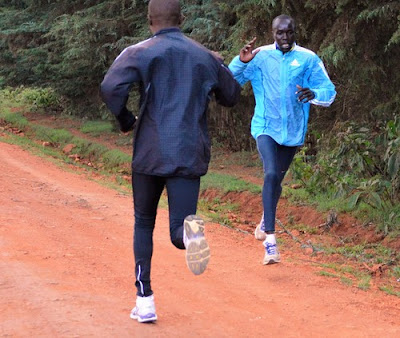 |
| Photo by Dylan Alcock on Unsplash |
As an online coach, I am, at times, asked questions by runners on how they can improve their running form and posture. Some even accompany their questions with a picture of them side by side with some of their favourite runners they would like to run exactly like them.
My opinion on the focus on running form and posture
My observation over time has been that running form and posture comes with one’s speed and fitness level, and not the other way around.
The faster you run, the better your running form and posture will look. In fact, even in a crowd when everyone is just standing, a keen observer (like you!) can be able to easily tell a faster runner from a crowd.
“He looks fast. Is he a runner?” This was the question I heard a number of times when a friend who was hosting me in Canada was being asked whenever we would come across some of his other acquaintances. I had gone there to compete in a few road races.
“I knew you were going to win this race, having just looked at you at the starting line,” an Ethiopian runner did confess to me at the finish line after I had just won the Sporting Life 10km race in Ottawa in 2017.
In all these, I never ever practiced how to look fast. Instead, I had trained on how to run fast and ended up looking fast in the process. This is exactly how it should be with the topic of running form and posture.
With the naked eye, one can tell when a runner is either running at a speed of about 22km/hr, or 10km/hr! One can watch a motorcyclist tackling a bend in a photo and tell whether it was moving at a slow or fast pace.
Having trained with the best road runners and world record holders for many years here, one thing I have observed among many of them is that they have not been focusing much on their running form and posture.
As to whether one should train to look faster rather than to run faster, we don’t usually train for running forms here in Kenya, and I am trying to apply the same principles to the runners I coach online.
We, I and a number of experienced runners around here who have discussed the topic with me, believe that each person’s body has its own form, so it is not something we should focus on… just like the preferences that some runners have regarding minimalist, barefoot, flat, cushioned and other different kinds of shoes for their training, or on many other controversial topics regarding running.
However, in whatever running form and posture one chooses to adopt for their running, there are a few techniques that will make one more efficient.

Be relaxed. Make sure that your shoulders are loose and your fists are not clenched. Do not exaggerate your stride length by trying to lengthen or shorten it. Just let it flow naturally. Running is the least complicated sport to engage in.
Running is natural, and you do not actually need an expert to tell you that your head should be above your shoulders while running!
If you need an online long-distance running coach to guide your training for your next marathon, You can enroll in my Online coaching programs
Follow my Twitter handle for running-related content.
Justin Lagat is a long distance runner. A World Athletics Certified long distance running Coach, and Freelance Sports Journalist. Work appears at World Athletics, RunBlogRun, Spikes Magazine, and Run Republic, among other websites.


3 responses to “The predicament on Running form and posture”
Excellent points and advice coach, very helpful to me as I have contemplated this very subject in my running journey. Thank you
You're welcome, Unknown. I am glad to be of help to you.
I read the ChiRunning book on a friend's recommendation.I had shin splints when running over 5K.On applying the leaning forward posture, a controlled fall, with feet landing behind the knee, the pain stopped.While I agree that running is natural and posture and technique indibid. I still think that there are some basic tips on posture and technique we can all learn.